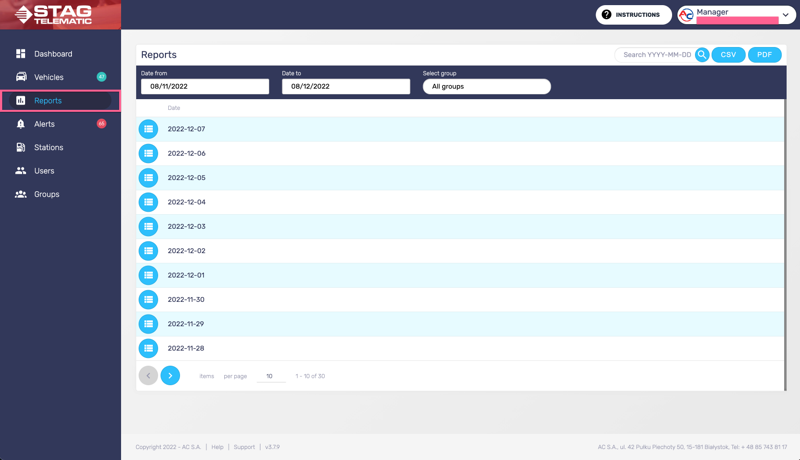Reports
Reports for the fleet can be managed in the Reports tab (figure 0.1)

1. Selecting date range
By default, there are the last 30 days of reports available. This is conditioned by the amount of data available to the application. In other words, it depends on how many (if any) vehicles are driving and generating data.
To specify a date range for your reports you can use date from and date to calendars (figure 1.1).

2. Filtering by group
You can specify a group you want your report selection. You can use this in combination with the date filter to specify your choice even further (figure 2.1).

3. CSV and PDF download
Filter reports by date and/or group ID. Once you managed to filter you will be able to download the results either as CSV or PDF. You can do this by pressing the CSV or PDF button in the top right corner (figure 3.1)

Explanations of the table
- Date - date of the report
- Vehicle ID - this is the custom ID vehicle was assigned
- Engine Type - engine type can be either petrol or diesel
- Distance km - total distance vehicle did in given date on both alternative and default fuel
- Distance default km - total distance vehicle did in given date on default fuel
- Distance alternative km - total distance vehicle did in given date on alternative fuel
- Drive time s - total time vehicle was driving in given date
- Drive time formatted - total time vehicle was driving in given date formated as HH:MM:SS
- Alternative fuel consumption (l) - total alternative fuel consumption in given date in l
- Alternative fuel consumption (l) - total alternative fuel consumption in given date in (l)
- Alternative fuel cost - cost for alternative fuel usage at given date
- Default fuel cost - cost for default fuel usage at given date
- Cost without alternative fuel - this is the cost you would have to pay by NOT using any alternative fuel at given date. Keep in mind you don't need to pay for the alternative fuel and the cost is only cost for the full distance driven on the default fuel. Crosschecking with savings = this sum, minus what you would pay normally (the difference) + alternative fuel cost (which you don't need to pay)
- Percent distance driven on alternative fuel - percentage of distance driven on alternative fuel
- Estimated savings - estimated savings for given date (more you drive on alternative fuel the bigger they are)
- Potential savings - estimated savings you could make if you would drive 100% distance on the alternative fuel
- CO2 savings - estimated CO2 savings for given date
- Data kb - approximate data transfer for given date
